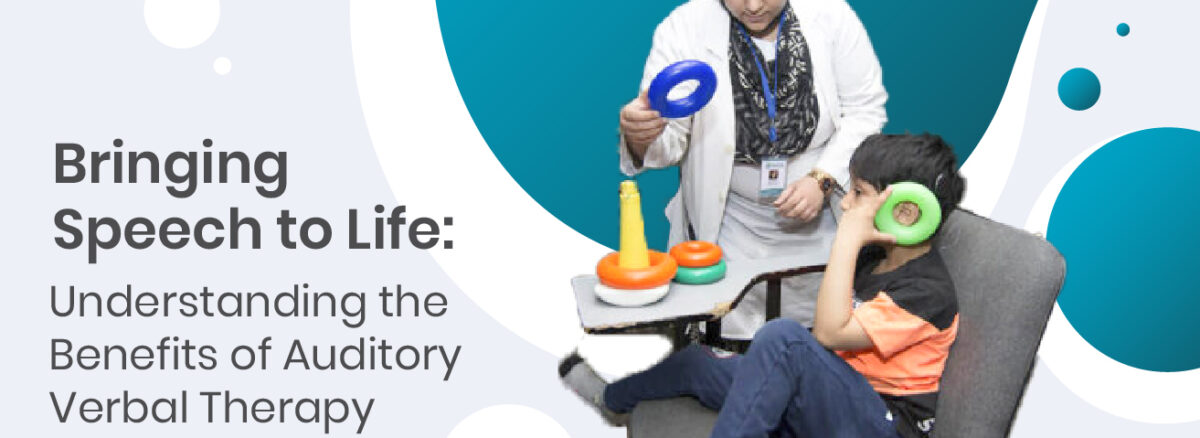- January 10, 2023
- admin
- Comment: 0
- blog, news, Uncategorized
Bringing Speech to Life: Understanding the Benefits of Auditory Verbal Therapy
Early intervention treatment for young children who are deaf and hard of hearing or who use hearing aids or cochlear implants is called auditory verbal therapy (AVT), sometimes called auditory-based therapy. Even if your kid has severe to profound hearing loss, their therapist can educate them to listen and speak verbally. The treatment sessions are actively participated in by parents and other carers who carry out the exercises at home. AVT therapy aims to provide your deaf or hard-of-hearing child the same opportunities to study, listen, and talk as hearing kids. Children who get auditory verbal treatment often do well in regular schools. They become friends, improve their self-esteem, perform well in arithmetic and reading, and live independently. Although cochlear implants and hearing aids can improve your child’s hearing, they still need to understand the signals they receive.
The most prevalent congenital condition a person is born with is hearing loss. However, just because your child has a hearing impairment doesn’t mean they can’t learn to hear. Children with cochlear implants or hearing aids frequently have exceptional audibility. According to experts, most deaf and hard-of-hearing children who get auditory verbal treatment by the time they enter first grade have comparable or even superior spoken language abilities to their hearing counterparts. Additionally, studies have shown that these kids perform better academically than deaf kids who don’t participate in AVT.
AVTtherapy is most effective when children begin treatment at a young age, as early as two to three months. Auditory-verbal therapy (AVT) may be helpful for your young kid if they are deaf or hard of hearing and are wearing hearing aids or cochlear implants. A universal newborn hearing screening should be performed on your infant (UNHS). Babies can receive hearing aids if necessary. Your kid can be assessed for cochlear implants as early as nine months of age if hearing aids are insufficient. It makes no difference if your child was born deaf or hard of hearing or if another factor contributed to their hearing impairment. For example, suppose they have difficulty hearing from one or both ears. If their condition is chronic or temporary, or if they have a hearing loss that ranges from mild to severe or profound, they may benefit from auditory-verbal treatment. Participate in your child’s treatment session. You will receive guidance from your healthcare practitioner as you go. If you learn the way they do, it will be beneficial. After that, your “duty” will be to keep instructing them between sessions with their clinician.
Speech and other sounds are louder when using hearing aids. Hearing aids can be adjusted to help people who hear some frequencies better than others. However, even though your child can hear you more clearly, they will still need to understand you. Your child’s doctor could suggest cochlear implants if hearing aids are insufficient for them. The cochlea is a hollow bone located inside the inner ear. Your inner ear converts sound waves into electrical impulses your brain can interpret when functioning correctly. A surgeon can place an implant into your cochlea if your inner ear requires assistance. Then, your youngster can access sound through the gadget since it avoids damage. To participate in auditory verbal therapy, your kid will likely need to be fitted with hearing aids and cochlear implants.
Auditory-verbal therapists follow a few guidelines:
- Encourage early detection of hearing loss in newborns, babies, toddlers, and young children and prompt audiological care and auditory-verbal therapy.
- Recommend immediate assessment and use of appropriate state-of-the-art hearing technology to obtain maximum benefits of auditory stimulation.
- Parents should be guided and coached on encouraging their kids to use hearing as the primary sensory modality for listening and spoken language development.
- By actively and consistently participating in their child’s tailored auditory-verbal treatment, parents may be guided and coached to become significant facilitators of their child’s listening and spoken language development.
- Parents should receive guidance and coach on how to set up settings that encourage listening so that children can pick up the spoken language as they go about their everyday activities.
- Parents should be advised and coached to assist their children in listening to their spoken language.
Applying the aforementioned guidelines will enable parents to serve as their children’s most significant “change agents,” Along with the fantastic “hearing sensory technology” of today, even children with severe and profound hearing loss can use auditory information to develop spoken language through listening!
Conclusions
The kid develops a listening attitude via play-based sessions utilising the Auditory Verbal method, making it automatic for them to be aware of the sounds around them. Speaking, playing, learning, and eventually working depend on hearing and listening. Every lesson learned throughout the workshops applies to everyday life. This implies that parents may turn common household tasks like setting the table or reading a tale into enjoyable opportunities for listening and learning at home.

